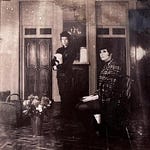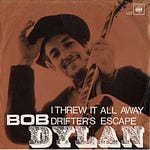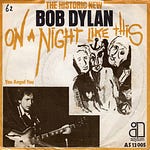After a thorough historical examination of the Gold Rush and what the world looked like in 1849, Daniel and Kelly break down "Days of '49," talk some Self Portrait and despair at the ups and downs of the last ten weeks.

EPISODE
SHOW NOTES
This episode begins with an absolute classic Sign on the Window moment, Kelly’s introduction explaining the California Gold Rush. As this is our first Self Portrait song and it’s kind of difficult to try to explain it. Naturally, you want to start with Greil Marcus:
What is this shit?
But I’ll let Bob take a stab:
That album was put out … [because] at that time … I didn’t like the attention I was getting. I [had] never been a person that wanted attention. And at that time I was getting the wrong kind of attention, for doing things I’d never done. So we released that album to get people off my back. They would not like me anymore. That’s … the reason that album was put out, so people would just at that time stop buying my records, and they did. [1981]
I said, ‘Well, fuck it. I wish these people would just forget about me. I wanna do something they can’t possibly like, they can’t relate to’ … And then I did this portrait for the cover. I mean, there was no title for that album … And I said, ‘Well, I’m gonna call this album Self Portrait’ … And to me it was a joke. [1984]”
Clinton Heylin calls it “an album of outtakes and live oddities from one of the least interesting periods of Dylan’s career.”
Before jumping into the song, Daniel lays out the historical context (11:00).
The revolutions of 1848 are still going on in Germany and Hungary. Elizabeth Blackwell was award her M.D. from the Medical Institute of Geneva, in New York, becoming the first woman doctor in the US. James K. Polk became the first President to have his photo taken just as Zachary Taylor was on his way to the office. St. Louis almost burns to the ground after a steamboat catches fire. The first segment of the Pennsylvania Railroad (from Lewistown to Harrisburg) opens for service.
Most relevant for the song: Regular steamboat service from the west to east coast began with the arrival of the SS California. Minnesota became a US territory (which ties into Bob) and Congress passed the Gold Coinage Act that allowed the minting of gold coins (which ties to “Days of ’49”). In November, the Constitution of California was ratified in a general election.
Births: Crazy Horse, Ivan Petrovich Pavlov, Emma Lazarus; Deaths: James Polk, Dolly Madison, Edgar Allan Poe, Frédéric Chopin.
Let analyze the song (16:00)
We are all over the place! #jollysaucycrewgoals. The origins of “bummer shore,” “gin sot,” “roving sign,” “hat full,” ragshag.” Kelly is into the chorus but Daniel reminds her that Dylan didn’t write this. We had a lot of fun with all the Bills.
But found ourselves feeling for Old Tom Moore, an example of the returning forty-niner, the disillusioned seeker of that elusive pot of gold. According to Michael Gray in his Bob Dylan Encyclopedia, Old Tom Moore is an example of a Yankee perspective,
it deals very consciously with a working community’s suffering, treated through the story of one family’s misfortunes, and that community’s annihilation. The song provides a timely epitaph to the destruction of the folk culture such communities produced, while taking the dynamics of its construction from that kind of culture. When, on the later album Self Portrait, Dylan returns to a genuinely old Yankee song, ‘Days of ’49’, he offers it quite rightly as a museum-piece even as he breathes new life into it.
So if this isn’t a Dylan original, where did the song come from (30:30)?
According to Professor William L. Alderson of Reed College, the first appearance of this song in print was in The Great New Popular Songster (San Francisco, 1872) and probably written by banjoist Charles Bensell, who died in 1877.
In the liner notes for Jeff Warner & Jeff Davis, “Days of Forty-nine,”
“Days of ‘49″ came originally from “Old Put’s Golden Songster”, put together by Old Put himself in Gold Rush Days. He found that, while there was no money in the mines, there were plenty of miners willing to pay for any kind of music or entertainment, this being a scarce commodity. The real money in the gold fields was made by the grocers, dry good salesmen, saloon keepers, and, I guess, musicians. Put probably intended the song to be comic, but people have since found sad truth in it.
In some ways, this relates to our first episode, "Honest With Me," as a reference of American history. We talk about it as “museum piece,” but that may be unfair. This song is about people wanting to live a dignified life and going out as they lived, which we can all learn from.
After 10 episodes, we check in with Kelly’s thoughts on Bob (39:00).
THE EPISODE’S BOOKLET & PLAYLIST
RECOMMENDATIONS
Then we recommend: Kelly’s been watching Naked and Afraid XL and listening to Politically Reactive.
Daniel’s been watching the final season of The Leftovers, the third season of Fargo and drinking mimosas and watching The Great British Bake Off.
Mainly, though, he's been listening to Sufjan Stevens magisterial Carrie and Lowell Live. After seeing the show in Portland on June 9, 2015, Daniel wrote (and read on the episode):
This experience was transportive. Not just with the lights or the sense of being abducted by aliens, but because he was singing about my home for almost 3 years and I was compelled to watch from afar. He mourned a complicated and difficult relationship that ended abruptly with no sense of finality, no resolution. He found strength in the pulses of wonder, regret, estrangement, attachment and chaos that ebbs and flows in these songs. It felt like he was talking to me when he said sadness is important but to wallow in misery too long helps no one. “Look up! Look up! Look up!,” he said, talking about the windows of the world we must keep open.“There’s light all around you!” I’d steeled myself to these songs – unlike the girl next to me who bawled the entire time – but I almost lost it in that split second of wondrous human recognition. It was dark, yes, but in the squalor, Sufjan suffused beauty and awe as our lens. Here’s suffering! Here’s resentment! Here’s sadness! he almost seemed to be screaming, But look! Here’s Perseus! Here’s the Pacific Ocean! Here’s transcendence! Sufjan sculpted a sonic spire that stretched into the exosphere and beyond, knocking firmly on the door to the Tower of Song.
ENDINGS (41:00)
655 songs to go.
Kelly guessed #67. It’s #123 – "Don't You Try Me Now" from The Bootleg Series, Vol. 11.
Next week: a deep Basement Tape cut, which I call by the wrong name so you can't even begin to guess!
Follow us wherever you listen to podcasts. See our real-time playlist See That My Playlist is Kept Clean on Spotify. Follow us intermittently on Twitter and Instagram.
Tell your friends about the show, rate and review wherever they let you, and consider supporting us by subscribing or at Patreon.












Share this post